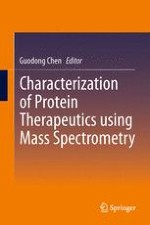2013 | OriginalPaper | Buchkapitel
7. Mass Spectrometry of Antibody–Drug Conjugates in Plasma and Tissue in Drug Development
verfasst von : Surinder Kaur, Keyang Xu, Ola Saad, Luna Liu, Tim Slattery, Randall Dere
Erschienen in: Characterization of Protein Therapeutics using Mass Spectrometry
Verlag: Springer US
Aktivieren Sie unsere intelligente Suche, um passende Fachinhalte oder Patente zu finden.
Wählen Sie Textabschnitte aus um mit Künstlicher Intelligenz passenden Patente zu finden. powered by
Markieren Sie Textabschnitte, um KI-gestützt weitere passende Inhalte zu finden. powered by
